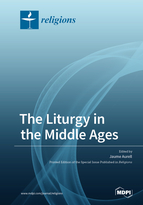The Liturgy in the Middle Ages
A special issue of Religions (ISSN 2077-1444). This special issue belongs to the section "Religions and Humanities/Philosophies".
Deadline for manuscript submissions: closed (20 December 2021) | Viewed by 25276
Special Issue Editor
Interests: medieval history; historiography; autobiography
Special Issues, Collections and Topics in MDPI journals
Special Issue Information
Dear Colleagues,
In early Christianity, the word “liturgy” referred to a public work or a service in the name of/on behalf of the people. In the Middle Ages, liturgy adopted multiple ceremonial forms, some of them remaining in the sacred sphere and others transferred to the temporal and political, gaining a central space in the public life. This issue will examine the concept, theory, practice, and representations of the liturgy in the Middle Ages, including its sacramental developments, its religious and political implications, its forms of ritualization, and its doctrinal presumptions. It aims to create a space for interdisciplinary dialogue between history, theology, canon law, art history, political philosophy, and symbolic anthropology. It privileges the examination of the transferences between the spiritual and the temporal, the sacred and the profane, the political and the religious.
Topics may focus on,
- Liturgy, sacraments, and ceremonies.
- Liturgy as ritual (ritual studies, gestures, symbols).
- Liturgy and materiality (i.e., relics, sacral objects, clothing).
- Liturgy and political rituals and royal ceremonies (i.e., acclamations, processions).
- Liturgy and doctrinal discussions.
- Liturgy and time.
- Liturgy and space: architecture, art, and ideas.
- Liturgy and music (chant books, Gregorian music).
- Liturgy and iconography.
- Liturgy and its audiences.
- Liturgy and political power.
- Liturgy and ecclesiastical hierarchy.
- Liturgy and manuscripts (liturgical books, ceremonials, missals, pontificals).
- Liturgy and law.
- Liturgy and devotion.
- Liturgy and faith (lex orandi, lex credendi).
- Liturgy and urban life (Eucharistic processions, royal funerals).
- Liturgy and political theology (transferences between the temporal and the spiritual).
- The politics of liturgy and the liturgy of politics.
Please send 500 word abstracts and a short bio before 30 May 2021 (deadline for Title and Abstract), to Guest Editor (saurell@unav.es). The authors will know that their proposals have been accepted before 15 June 2021. Final papers will be due on 20 December 2021.
Prof. Dr. Jaume Aurell
Guest Editor
Manuscript Submission Information
Manuscripts should be submitted online at www.mdpi.com by registering and logging in to this website. Once you are registered, click here to go to the submission form. Manuscripts can be submitted until the deadline. All papers will be peer-reviewed. Accepted papers will be published continuously in the journal (as soon as accepted) and will be listed together on the special issue website. Research articles, review articles as well as short communications are invited. For planned papers, a title and short abstract (about 100 words) can be sent to the Editorial Office for announcement on this website.
Submitted manuscripts should not have been published previously, nor be under consideration for publication elsewhere (except conference proceedings papers). All manuscripts are thoroughly refereed through a double-blind peer-review process. A guide for authors and other relevant information for submission of manuscripts is available on the Instructions for Authors page. Religions is an international peer-reviewed open access monthly journal published by MDPI.
Please visit the Instructions for Authors page before submitting a manuscript. Submitted papers should be well formatted and use good English. Authors may use MDPI's English editing service prior to publication or during author revisions.
Keywords
- liturgy
- Middle Ages
- sacraments
- ceremonies
- ritual






